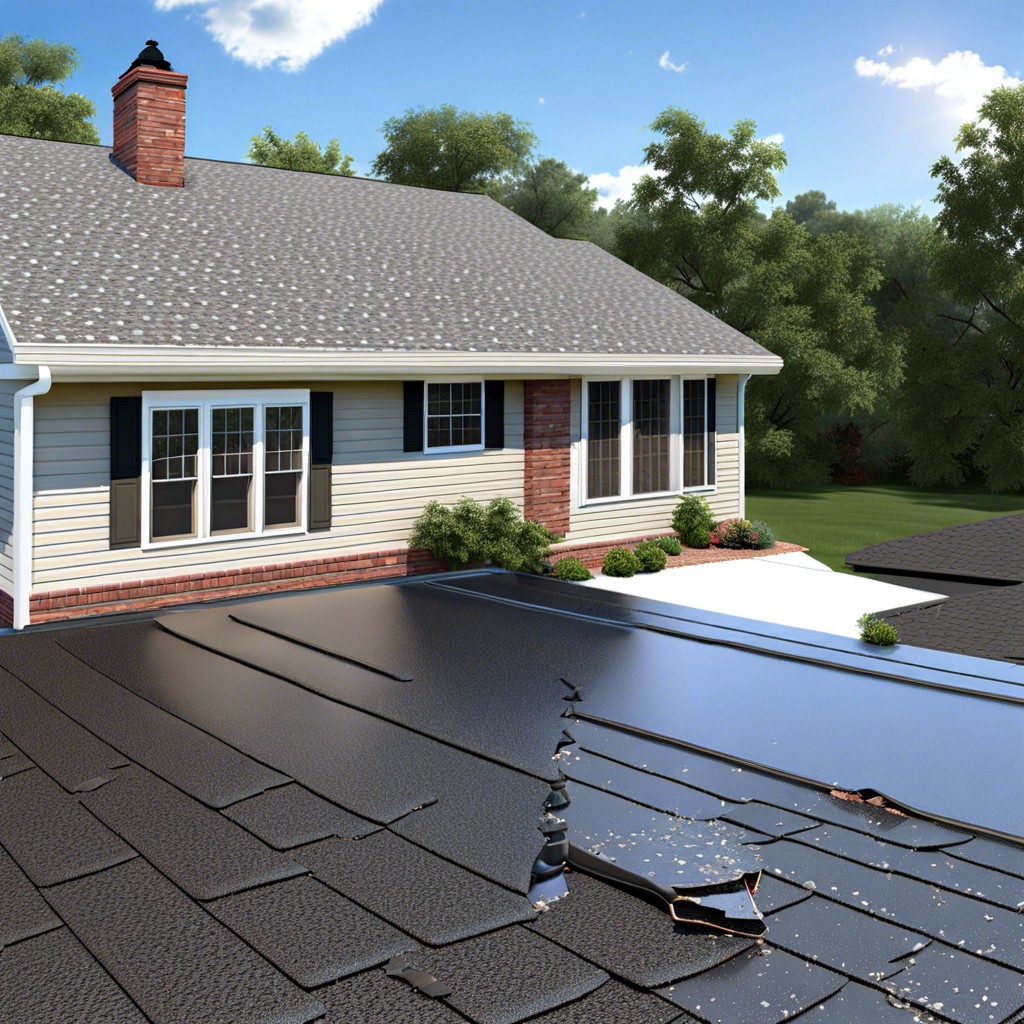Last updated on
Learn to spot hail damage on your roof and find out what steps to take if you suspect your roof is affected.
Key takeaways:
- Hail damage can cause divots, granule loss, and cracked shingles.
- Look for dents, cracks, and missing shingles on your roof.
- Even small hailstones can cause significant damage to your roof.
- Hail damage can be repaired, from sealant to full roof replacement.
- Check your insurance policy for coverage and file a claim promptly.
Hail Damage to Asphalt and Composition Shingles

Wind in your shingles? They’re not big fans of hail, either. When hail strikes, asphalt and composition shingles can suffer some gnarly damage. Think divots in a golf course, but less fun.
Imagine a baseball-sized bully landing on your roof. Impact marks, granule loss, and bruising are common injuries. Granules, those tiny bits of rock on your shingles, act like sunscreen. When hail knocks them off, it’s like your roof forgot its SPF.
Keep an eye out for cracked or broken shingles. Hail can turn those reliable soldiers into crispy crackers. And always remember: a soft spot isn’t a trampoline; it’s a red flag! If you spot any, it’s time to call in the pros.
Even smaller hail can wreak havoc. While a few gentle taps might seem harmless, repeated pelting can still lead to long-term problems. Treat your roof like a game of Jenga: steady attention prevents the big collapse.
How Do You Know If Your Roof or Exterior Has Hail Damage?
Start by spotting the obvious signs. Look for dents, cracks, or missing shingles on your roof. Pay attention to granules in gutters—more than usual could mean hail trouble. Check metal components like vents, flashing, and gutters for dings.
On the exterior, inspect siding and windows for cracks and chips. Hail likes to share the damage love across your property.
Don’t skip looking at patio furniture and cars for dents—often a telltale sign storm-related mayhem is lurking up top.
A quick once-over from the attic: see any leaks or water stains? Bingo, your roof might need some TLC. High five, detective—you’re doing great.
Can 1 Inch Hail Cause Damage to a Roof?
Even seemingly harmless, dime-sized hail can pack quite a punch. The telltale pockmarks left on your roof could actually mean trouble. Here’s why:
- Impact: Even small hailstones can make a significant dent, especially when propelled by high winds.
- Granule Loss: Hail often knocks granules off asphalt shingles, impairing the roof’s protective layer.
- Cracks: Small cracks might form in the shingles, leading to leaks that can cause further structural damage over time.
- Age Matters: Older roofs might not stand up as well to hail as newer installations.
So, don’t let size fool you. Even little hailstones can spell big trouble for your roof.
Can Hail Damage to a Roof Be Repaired?
Absolutely! Repairing hail damage is not just possible but often essential to maintain your roof’s integrity. Here’s what you need to know:
First, assess the damage. This might mean getting a professional roofer up there to have a closer look. They can spot issues that might escape your untrained eye, like bruising or granule loss.
Next, small dings and divots might only require a bit of sealant or a quick shingle replacement. Easy peasy.
For more serious damage, entire sections of the roof might need replacing. Yes, it’s a bit more costly, but necessary to prevent future headaches.
Don’t neglect the flashing and gutters. Hail doesn’t discriminate; it goes for the jugular. Check these components and repair or replace as needed to ensure everything channels water away efficiently.
Lastly, always take photos. Not for your Instagram, but for insurance claims. Documentation will be your best friend when proving the extent of damage to your insurance company.
There you go, no need to break a sweat. Roof repairs after a hailstorm can be tackled systematically and effectively.
Is a Hail Damaged Roof Covered By Insurance?
Reviewing your homeowner’s insurance policy can feel like reading ancient hieroglyphics, but when hail strikes, it pays to decipher those symbols.
Typically, standard homeowner’s insurance covers roof damage caused by hail. However, policies vary, and the devil’s in the details.
First, check for specific exclusions or limitations related to severe weather events. Some policies may not cover cosmetic damage that doesn’t affect the roof’s functionality.
Next, consider the deductible. Does your policy have a separate deductible for wind and hail damage? If so, it’s probably higher than the standard one – bummer, right?
Also, be aware of policy time limits. Insurance companies usually require you to file a claim within a certain timeframe after the damage occurs. Procrastinators beware.
Documentation is your friend. Take photos of the damage and keep receipts for repairs and inspections. Insurers love evidence.
Last but definitely not least, if in doubt, ask your insurer. Friendly chats can clear up confusing clauses faster than you can say “hailstorm.”




